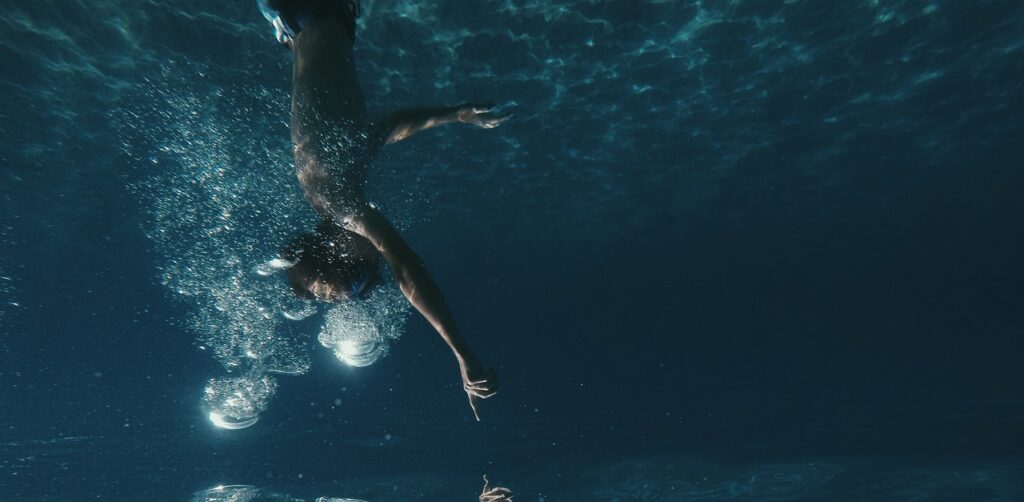

Freediving without a snorkel is both possible and preferred by some freedivers as a purer form of freediving experience. Snorkels are very much an optional piece of freediving equipment and the simplest snorkel can be the best if you want to avoid extra weight, bulk and drag.
A snorkel is a completely optional piece of freediving equipment which some divers choose and others prefer not to use. You must learn correct freediving snorkeling technique if you do use a snorkel.
The True Story Book of Freediving Champion Audrey Mestre and the Story of Her Death
View on Amazon: The Last Attempt (Opens new tab)


Top rated read
You may have observed freedivers diving with and without snorkels and wondered about the role of snorkels in freediving. Our article tells you more about the options for using a snorkel in freediving, including the best snorkel to choose and the different types available.
Do you need a snorkel for freediving?
You definitely do not need a snorkel for freediving and many recreational and competitive freedivers never use a snorkel. Snorkel use depends entirely on diver preferences including how they choose to prepare themselves for a dive (the breath-up) and whether they’re diving for recreation and wanting to see more of the underwater world.
Can you freedive with a snorkel?
You can freedive with a snorkel but should learn the correct techniques for securing, controlling and clearing the snorkel while freediving in order to stay safe and have fun.
To help you, we’ve written a full article detailing how to freediving with a snorkel (opens new tab).
Most importantly, freedivers must always remove their snorkel mouthpiece before descending in order to avoid drowning hazard. When submerged with the mouthpiece still in place, only the tongue stops water from running into the lungs through the mouth. In the case of shallow water blackout or other loss of consciousness, the tongue would automatically relax and water could flood into the lungs.
While you are fully submerged, the snorkel will fill with water. This water will need to be cleared from the breathing tube at the surface before you can breath through it again.
A snorkel and mask can be used in a range of ways for freediving including:
- Viewing water conditions: Freedivers may want to check water visibility, or the location of beauty spots or possible hazards.
- Monitoring a diving buddy’s safety: Every freediver should dive with a diving buddy who can observe their movements and be alert to any issues or need for rescue. A snorkel and mask make it easier to follow your diving buddy’s movements while face-down in the water.
- Freedive preparation (breath-up): Before descending, freedivers relax in the water and practice breath-up exercises in order to better fill their lungs with oxygen-rich air. Freedivers may do this on their backs, but some prefer to be face-down with the aid of a snorkel, especially if the water is rough. Initial submersion helps to trigger the Mammalian dive reflex (MDR) and its diving-optimized physical responses.
- Combining recreational freediving with snorkeling: Recreational dreedivers might wish to swim and dive around reefs or other underwater features. A snorkel makes it easier to view and choose the best freediving locations, or explore an area at shallower depths before diving more deeply.
What kind of snorkel do you use for freediving?
If you browse in a diving shop you may see a wide range of snorkels available for sale. The best freediving snorkel could be the simplest snorkel available. J-type snorkels are a simple, lightweight snorkel which is popular and frequently used by freedivers.
While there are similarities between snorkeling, scuba diving and freediving equipment, freediving snorkels will have slight differences to snorkels for scuba or simple snorkeling. The design and construction of freediving snorkels allows freedivers to breathe-up, dive and return to the surface smoothly and comfortably. When choosing your freediving snorkel you should consider:
Material
Freediving snorkels should be constructed from flexible materials which can bend comfortably but spring back easily into their original shape after experiencing high pressures (e.g. silicone or high-tech polymers).
Some of the harder, more rigid plastics used in standard snorkels might cause discomfort or pain. Similarly, very soft materials are unsuitable because they can be too compressed by water pressure, restricting airflow when you return to the surface and need to breath again.
Mouthpiece
Compared to scuba and snorkeling snorkels, freediving snorkels should have a smaller and softer mouthpiece. The mouthpiece angle should also be at a slightly altered, more comfortable angle, connecting to a curved breathing tube that stays in place easily.
Breathing tube
A snorkel breathing tube with a mid-sized diameter is well-suited to freediving. Narrower tubes create the risk of not getting enough air at the start and end of a dive. Wider tubes may require far more effort to clear on return to the surface and could delay return to normal breathing.
Accessories
Some freedivers prefer not to use snorkels with accessories like dry-top / splash covers or purge valves as these mechanisms can add unnecessary weight, bulk and drag to the snorkel. There is also a risk that some of these accessories could restrict air-flow during breathe-up and recovery.
What is the difference between a dry and semi dry snorkel?
Dry and semi-dry snorkels are similar in ruction and appearance.
Dry snorkels contain both a cover and floating seal mechanism at the top of the breathing tube. This prevents water entering the tube either at or surface or when the diver submerges. The float valves are only activated when the snorkel is completely underwater.
Dry snorkels can also have splash guards, flex tubes or purge valves to counter waves and spray at the surface. The splash guard is normally an extra plastic piece which sits over the snorkel opening, and is shaped to direct water away.
Semi-dry snorkels may be almost identical to dry snorkels but do not have the float valve feature.
